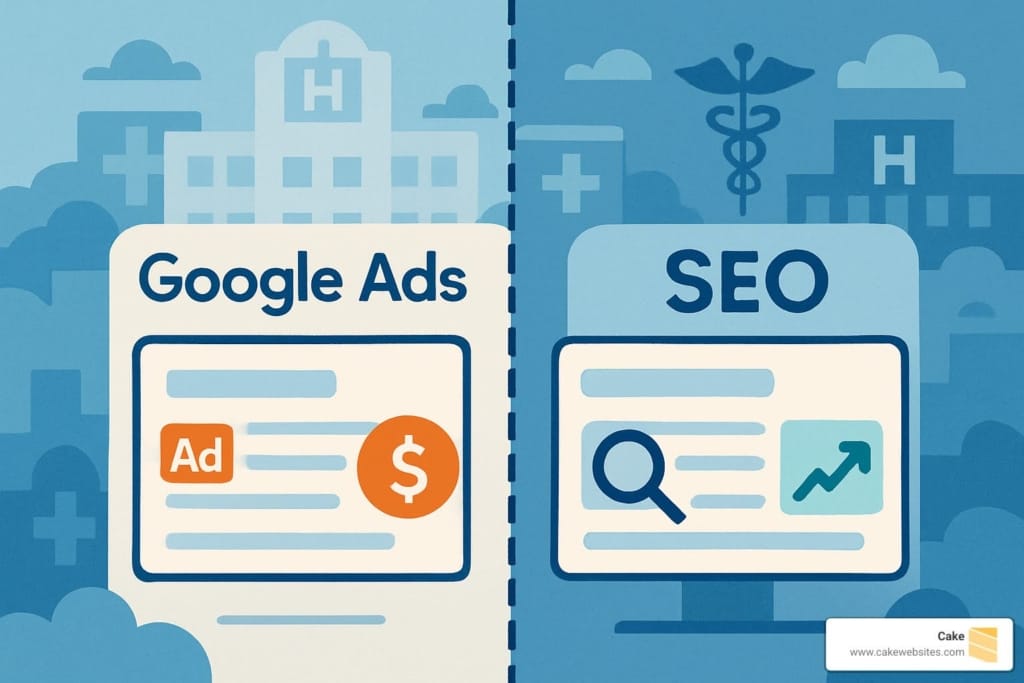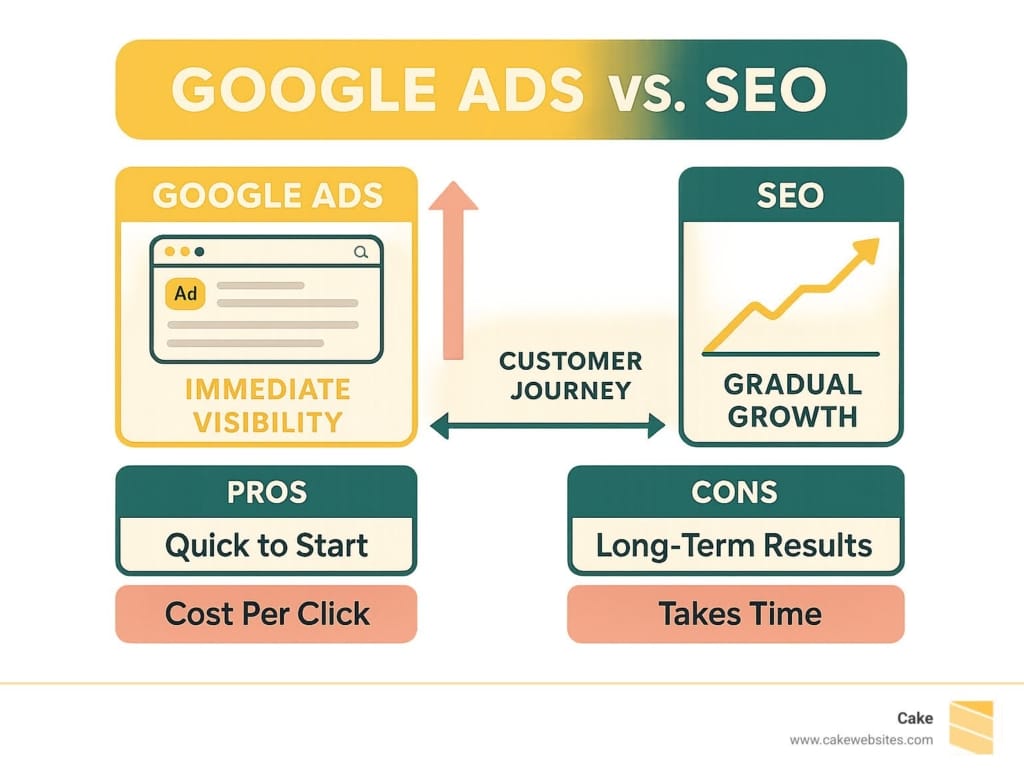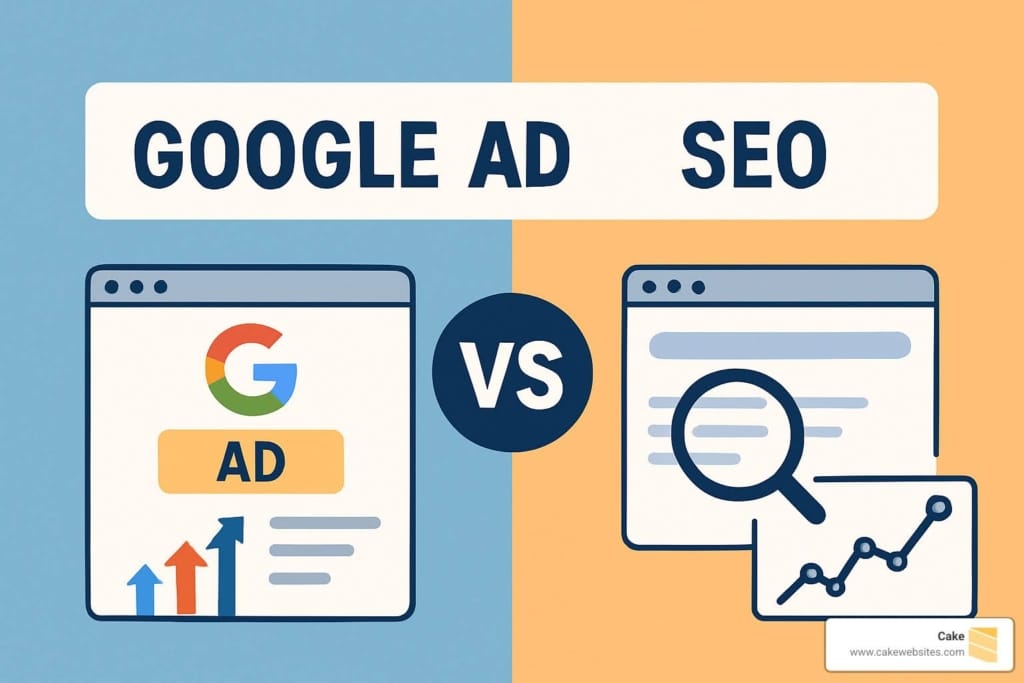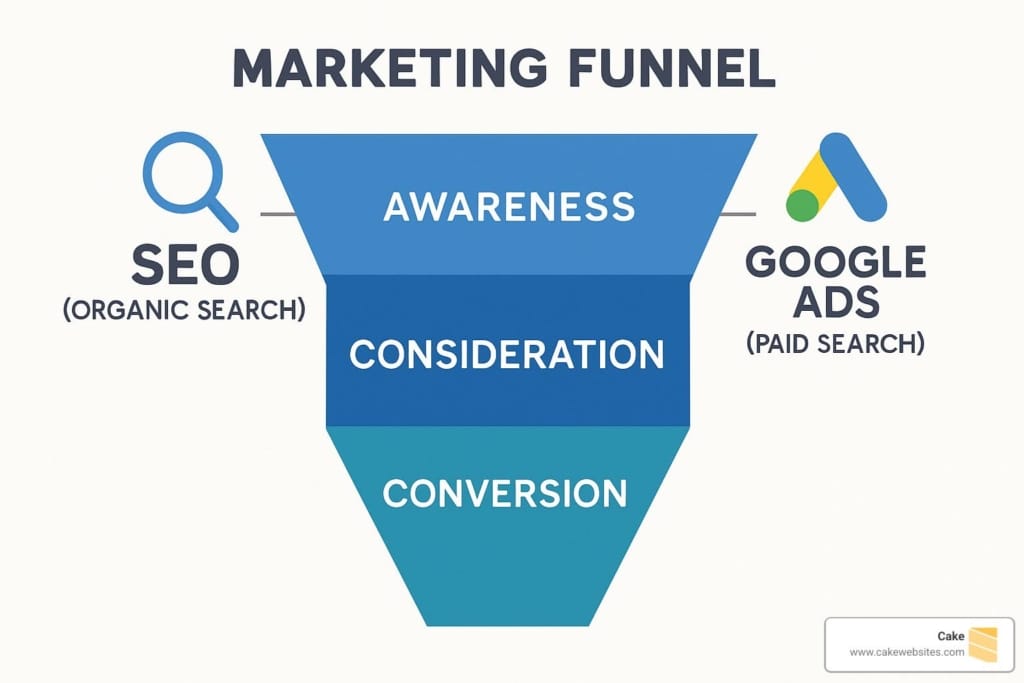
Do I need Google Ads, or is SEO enough?

When it comes to growing your medical practice online, the Google Ads vs. SEO question isn’t just a marketing decision—it’s about how you’ll connect with future patients.
We have seen countless cosmetic surgeons wrestle with this choice. They come to us at Cake wondering if they should pour their marketing dollars into immediate visibility or long-term organic growth.
The truth? Each approach serves different needs at different moments in your practice’s journey. Let’s break down what each option brings to the table:
| Feature | Google Ads | SEO |
| Speed | Immediate results (48 hours+) | Gradual results (3-6 months) |
| Cost | Pay per click ($2-$10+ per click in medical field) | Investment in content and optimization |
| Longevity | Stops when you stop paying | Continues working long-term |
| Trust | Lower (users know they’re ads) | Higher (users trust organic results) |
| Targeting | Precise audience and location control | Broader organic reach |
Think of Google Ads as your practice’s sprint runner—fast out of the blocks when you need immediate visibility. Perhaps you’ve just added a new treatment option or you’re looking to fill appointments during traditionally slower months. With ads, you can be at the top of search results tomorrow morning.
SEO, on the other hand, is your marathon champion. Search engines remain the lifeblood of a medical practice’s website. While social media certainly plays its role, search is where potential patients go when they’re actively looking for the procedures you offer—that magical moment when they’re ready to make a decision.

Google Ads vs. SEO: Core Concepts Explained
Before diving into which strategy is right for your practice, let’s clarify what Google Ads vs. SEO actually means in the context of medical marketing.
SEO (Search Engine Optimization) is the art and science of earning visibility in search results naturally. Think of it as building your practice’s reputation in Google’s eyes – improving your content quality, fine-tuning your website structure, and earning “votes of confidence” through backlinks from other trusted websites.
Google Ads (formerly Google AdWords) is more like renting premium real estate at the top of search results. You bid on keywords relevant to your practice, and you only pay when someone actually clicks on your ad – hence the term “pay-per-click” (PPC).
The fundamental difference? SEO is about earning visibility organically over time, while Google Ads is about buying visibility instantly – both valid approaches with different strengths.

When a potential patient searches “best cosmetic surgeon near me,” they’ll typically see a search results page with distinct sections:
First, up to four Google Ads at the top (marked with a small “Ad” label), then the local map results (often called the “maps pack” or “3-pack”), followed by organic search results below. Each section represents different opportunities to connect with patients actively looking for your services.
Both strategies target the same valuable audience – people actively searching for your services – but they operate on fundamentally different models. SEO functions on trust and authority, with Google’s algorithms assessing hundreds of factors to determine which sites deserve top rankings. Google Ads, meanwhile, operates on an auction model where your position depends on your bid amount and Quality Score (Google’s rating of your ad quality and relevance).
For cosmetic surgeons and medical practices, this difference matters – especially considering that a large percentage of all clicks go to the top results. Your visibility strategy directly impacts your patient acquisition success.
Speed, Cost & ROI: Choosing Short-Term or Long-Term Wins
When weighing Google Ads vs. SEO for your medical practice, the age-old question of “how soon” versus “how sustainable” takes center stage.
Google Ads vs. SEO speed test
If patience isn’t your strongest virtue, Google Ads delivers the instant gratification many practice owners crave. Within just 48 hours of setup, your practice can appear prominently at the top of search results. The moment your ads receive approval, patient inquiries begin flowing in, with measurable results visible within days.
SEO, meanwhile, plays the long game. Those first encouraging signs might take 4-12 weeks to appear, with meaningful ranking improvements typically requiring 3-6 months of consistent effort. For highly competitive medical terms like “best plastic surgeon” or “liposuction specialist,” the journey to page one could stretch to 6-12 months.
This timing difference makes Google Ads particularly valuable when you need quick results – perhaps you’ve just hired a new surgeon with availability to fill, you’re launching a seasonal promotion on CoolSculpting before summer, or you’re introducing a new treatment option that patients don’t yet know to search for.
Google Ads vs. SEO cost breakdown
The financial picture differs dramatically between these approaches. Google Ads operates on a pay-to-play model where medical keywords command premium prices. Terms in the medical field typically range from $2-$30+ per click, with competitive cosmetic procedure terms like “mommy makeover” or “rhinoplasty surgeon” often exceeding $10 per click.
Most established cosmetic practices invest between $3,000-$10,000+ monthly on Google Ads – with the sobering reality that when you pause spending, your visibility vanishes overnight.
SEO, by contrast, requires an initial investment in website optimization and quality content creation, typically ranging from $2,000-$5,000+ monthly for professional services. The key difference? SEO builds equity. The authority and rankings you develop continue generating patient inquiries even during periods when you reduce investment.
The ROI calculation feels straightforward with Google Ads: if you spend $1,000 in advertising to acquire a patient for a procedure that generates $5,000 in profit, your return is clear and immediate.
SEO’s return builds more gradually but compounds impressively over time. A well-optimized page about “non-surgical rhinoplasty recovery” might bring 500 monthly visitors for years to come, steadily converting a percentage into consultations and procedures. This explains why most marketers already investing in SEO plan to maintain or increase their investment.
For most of our medical clients at Cake, we’ve found the sweet spot lies in a balanced approach: using Google Ads as the patient acquisition accelerator while simultaneously building SEO assets that gradually reduce dependence on paid traffic. This combination provides both immediate results and long-term sustainability—exactly what a thriving practice needs.
Pros, Cons & Ideal Scenarios
When it comes to Google Ads vs. SEO, there’s no one-size-fits-all answer for medical practices. Each approach has its own strengths and limitations that make it more suitable for different situations.
When to Choose SEO
SEO creates a foundation of trust that’s particularly valuable in the medical field. With consumers more likely to choose brands they trust, the credibility that comes with organic rankings can be golden for your practice.
Building lasting authority happens naturally with SEO. When potential patients see your practice appearing in organic results for their questions about procedures, you become their trusted advisor before they even walk through your door.
The compounding returns of SEO are truly remarkable. Unlike ads that disappear the moment you stop paying, a well-crafted article on “what to expect after liposuction” can bring you patients for years to come. As your domain authority grows, Google begins to trust your site more, making it easier for new content to rank well.
SEO also excels at targeting the entire patient journey. From initial research phases (“non-surgical face lift options”) to addressing concerns (“botox side effects”) and supporting recovery (“rhinoplasty recovery timeline”), your content can guide patients every step of the way.
Of course, SEO isn’t without challenges. It’s time-intensive, often taking months to see meaningful results. It also makes you somewhat vulnerable to algorithm changes – Google makes updates seasonally, and major ones can temporarily affect rankings. Plus, medical terms are highly competitive, with large hospital systems and directories often dominating search results.
SEO makes the most sense when:
- You’re building a long-term practice in your community
- Your procedures involve lengthy research cycles
- You have unique expertise or specializations to showcase
- You’re in a market where paid clicks are prohibitively expensive
- You want to gradually reduce your marketing costs over time
When Google Ads Rule
The most compelling advantage of Google Ads is the immediate visibility it provides. While your SEO efforts are still gaining traction, ads can put you at the top of search results instantly, generating leads within days and helping fill your appointment schedule.
The targeting capabilities are remarkably precise, allowing you to focus on specific zip codes around your practice, schedule ads only during office hours when staff can answer calls, and even target particular demographics most likely to be interested in your services.
Google Ads also offers complete control and flexibility. Need to promote a seasonal special on body contouring before summer? Want to pause campaigns during periods when you’re fully booked? With Google Ads, you can adjust your messaging and budget in real-time to match your practice’s needs.
The platform also provides measurable ROI and testing opportunities. You can track exactly which keywords and ads are generating consultations, A/B test different messaging to see what resonates with potential patients, and continuously optimize based on performance data.
However, Google Ads does require ongoing investment – traffic stops immediately when campaigns pause, and competitive medical keywords can be expensive (often $10+ per click for terms like “breast augmentation” or “facelift”). There’s also a lower trust factor, as some users actively avoid clicking on ads, particularly for important medical decisions. Additionally, the management complexity shouldn’t be underestimated – maintaining good Quality Scores and optimizing campaigns requires expertise.
Google Ads typically works best when:
- You’ve just opened a new practice or location
- You’re introducing a new procedure or special offer
- You need to fill appointment gaps quickly
- You operate in a highly competitive market where organic ranking is difficult
- You want to target very specific geographic areas
- You need precise control over your marketing message
The beauty of working with an experienced partner like Cake is that we can help you identify the perfect balance between these approaches, creating a strategy that delivers both immediate results and long-term growth for your practice.
Think of Google Ads as sprinting and SEO as marathon training. One gets you to the finish line quickly but leaves you breathless (and with a lighter wallet), while the other builds endurance that carries you forward long after your initial effort.
Making Both Channels Work Together
While we often talk about Google Ads vs. SEO as competing strategies, the truth is they work best as teammates rather than rivals. At Cake, we’ve seen our most successful medical practices accept both approaches as part of a unified digital strategy.
Think of it like this: when a potential patient sees your practice in both paid and organic listings, you’re not just getting more visibility – you’re building credibility. You’re essentially telling them, “Yes, we belong at the top of these results.”

When you dominate both paid and organic search results, you’re not just increasing visibility – you’re creating a perception of market leadership. And this dual presence can boost your overall click-through rates, an advantage in competitive medical fields.
This integrated approach allows you to address different stages of the patient journey. Your SEO content builds trust during the research phase, while Google Ads capture those high-intent searches from patients ready to book a consultation. And as your organic rankings improve over time, you can gradually shift budget from ads to content creation, balancing short and long-term objectives.
Frequently Asked Questions about Google Ads vs. SEO
The Google Ads vs. SEO debate isn’t really about finding a single perfect marketing solution—it’s about crafting the right blend of strategies that will help your unique medical practice thrive.
At Cake, we’ve watched the most successful medical practices take a nuanced approach. Rather than viewing this as an either/or decision, they strategically leverage both channels:
- They use Google Ads for immediate patient acquisition while simultaneously building their organic visibility
- They let each channel inform and strengthen the other through shared data and insights
- They gradually shift the balance as organic rankings improve to optimize their marketing ROI
- They maintain flexibility to adapt to seasonal needs and evolving practice growth objectives
With over 20 years of experience helping medical practices grow, we’ve witnessed how this integrated approach creates sustainable success for cosmetic surgeons, dermatologists, and other specialists.
Ready to develop a personalized strategy that leverages the strengths of both Google Ads and SEO for your practice? Learn more about our Search Engine Optimization (SEO) services and how we create customized marketing plans that deliver real results.
